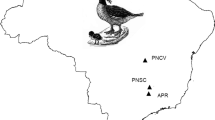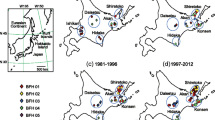Abstract
The redshank (Tringa totanus) is declining throughout Europe and to implement efficient conservation measures, it is important to obtain information about the population genetic structure. The aim of the present study was two-fold. First, we analysed the genetic variation within and between populations in the Baltic region in southern Scandinavia. Evidence of genetic structure would suggest that different populations might require separate management strategies. Second, in an attempt to study large-scale genetic structure we compared the Baltic populations with redshanks from northern Scandinavia and Iceland. This analysis could reveal insights into phylogeography and long-term population history. DNA samples were collected from six breeding sites in Scandinavia presumed to include two subspecies (totanus and britannica) and a further sample from Iceland (subspecies robusta). Two methods were used to study the population genetic structure. Domain II and III of the mitochondrial control region was analysed by DNA sequencing and nuclear DNA was analysed by screening amplified fragment length polymorphism (AFLP) markers. Mitochondrial DNA showed no variation between individuals in domain II. When analysing an 481 bp fragment of domain III seven haplotypes were found among birds. On the basis of mtDNA sequences, redshanks showed some evidence of a recent expansion from a bottlenecked refugial population. Bayesian analyses of AFLP data revealed a significant genetic differentiation between suggested subspecies but not between populations within the Baltic region. Our results indicate that populations of redshanks in Europe constitute at least three separate management units corresponding to the recognised subspecies.
Similar content being viewed by others
References
A Baker T Piersma L Rosenmeier (1994) ArticleTitleUnraveling the intraspecific phylogeography of knots Calidris canutus: A progress report on the search for genetic markers J. Ornithol. 135 599–608
S Bensch T Andersson S Åkesson (1999) ArticleTitleMorphological and molecular variation across a migratory divide in willow warblers, Phylloscopus trochilus Evolution 53 1925–1935
S Bensch S Åkesson DE Irwin (2002) ArticleTitleThe use of AFLP to find an informative SNP: Genetic differences across a migratory divide in willow warblers Mol. Ecol. 11 2359–2366
BirdLife International/European Bird Census Council (2000). European Bird Populations: Estimates and Trends. BirdLife International, Cambridge, UK (BirdLife Conservation Series no. 10)
RL Borowsky (2002) ArticleTitleEstimating nucleotide diversity from random amplified polymorphic DNA and amplified fragment length polymorphism data Mol. Phyl. Evol. 18 143–148
D Campbell P Duchesne L Bernatchez (2003) ArticleTitleAFLP utility for population assignment studies: Analytical investigation and empirical comparison with microsatellites Mol. Ecol. 12 1979–1991
HR Christensen (2003) ArticleTitleDanmarks engfugle i krise Fugle og Natur (Dansk Ornitologisk Forening) 23 IssueID2 4–7
Cramp S, Simmons KEL (1983). Birds of the Western Palearctic, Vol. 3. Waders to Gulls. Oxford University Press, Oxford
Engelmoer M, Roselaar CS (1998). Geographical Variation in Waders: Redshank, pp: 226–243. Kluwer Academic Publishers, Dordrecht
R Griffiths MC Double K Orr RJG Dawson (1998) ArticleTitleA DNA test to sex most birds Mol. Ecol. 7 1071–1075
Hagemeijer WJM, Blair M (1997). The EBCC Atlas of European Breeding Birds. Academic Press.
WG Hale (1971) ArticleTitleA revision of the taxonomy of the Redshank Tringa totanus Zool. J. Linn. Soc. 53 177–236
KE Holsinger PO Lewis DK Dey (2002) ArticleTitleA Bayesian method for analysis of genetic population structure with dominant marker data Mol. Ecol. 11 1157–1164
Höglund J, Johansson T, Beintema A, Schekkerman H (2001). Phylogeography of the Black-tailed godwit Limosa limosa: substructuring revealed by mtDNA control region sequences. In: Habitat selection, nest predation and conservation biology in a black-tailed godwit (Limosa limosa) population. Johansson T. PhD thesis. University of Uppsala, Sweden.
D.B. Jackson R.E. Green (2000) ArticleTitleThe importance of the introduced hedgehog (Erinaceus europaeus) as a predator of the eggs of waders (Charadrii) on machair in South Uist, Scotland Biol. Conserv. 93 333–348
T Johansson S Hedgren T Kolehmainen L Tydén (2002) Återinventering 2001 av häckande fåglar på gotländska strandängar Länsstyrelsen i Gotlands län Visby
K Kraaijeveld EN Nieboer (2000) ArticleTitleLate Quaternary paleogeography and evolution of arctic breeding waders Ardea 88 193–205
J Merilä M Björklund AJ Baker (1997) ArticleTitleHistorical demography and present day population structure of the greenfinch, Carduelis chloris – an analysis of mtDNA control region sequences Evolution 51 946–956
H Meltofte (1993) ArticleTitleVadefugletrækket gennem Danmark. De involverede bestande, deres trwktider og trækstrategier Dansk. Orn. Foren. Tidsskr. 87 1–180
M Nei (1987) Molecular Evolutionary Genetics Columbia University Press New York
M Nei L Tajima (1983) ArticleTitleMaximum likelihood estimation of the number of nucleotide substitutions from restriction site data Genetics 105 207–217
R Nielsen J Wakeley (2001) ArticleTitleDistinguishing migration from isolation: A Marlow chain Monte Carlo approach Genetics 158 885–896
K Norris E Brindley T Cook S Babbs CF Brown R Yaxley (1998) ArticleTitleIs the density of redshank Tringa totanus nesting on saltmarshes in Great Britain declining due to changes in grazing management? J. Appl. Ecol. 35 621–634
D Paetkau W Calvert I Sterling C Strobeck (1995) ArticleTitleMicrosatellite analysisof population structure in Canadian polar bears Mol. Ecol. 4 347–354
SR Palumbi F Cipriano MP Hare (2001) ArticleTitlePredicting nuclear gene coalescence from mitochondrial data: The three-time rule Evolution 55 859–868
J Pettersson (2001) Fåglar på Ölands sjömarker 1988 och 1998 Länsstyrelsen i Kalmar län Kalmar
T Piersma A Baker (2000) Life history characteristics and the conservation of migratory shorebirds LM Gosling WJ Sutherland (Eds) Behaviour and Conservation. Cambridge University Press London 105–124
CR Primmer T Borge J Lindell GP Sætre (2002) ArticleTitleSingle nucleotide polymorphism characterization in species with limited available sequence information: High nucleotide diversity revealed in the avian genome Mol. Ecol. 11 603–612
J Rozas R Rozas (1999) ArticleTitleDnaSP version 3: An integrated program for molecular population genetics and molecular evolution analysis Bioinformatics 15 174–175
Schneider S, Roessli D, Excoffier, L (2000). Arlequin ver 2,000: A Software for Population Genetics Data Analysis. Genetics and Biometry Laboratory, University of Geneva
R.W. Summers L.G. Underhill (1991) ArticleTitleThe relationship between body size and time of breeding in Icelandic redshanks Tringa t. robusta Ibis 133 134–139
F Tajima (1989) ArticleTitleStatistical method for testing the neutral mutation hypothesis by DNA polymorphism Genetics 123 585–595
PS Thompson WG Hale (1993) ArticleTitleAdult survival and numbers in a coastal breeding population of Redshank Tringa totanus in northwest England Ibis 135 61–69
P Vos R Hogers M Bleeker et al. (1995) ArticleTitleA new technique for DNA fingerprinting Nucleic Acids Res. 23 4407–4414
PW Wenink AJ Baker M.G.J. Tilanus (1994) ArticleTitleMitochondrial control-region sequences in two shorebird species, the Turnstone and the Dunlin, and their utility in population genetic studies Mol. Biol. Evol. 11 22–31
PW Wenink AJ Baker H–U Rosner MGJ Tilanus (1996) ArticleTitleGlobal miochondrial DNA phylogeography of Holarctic breeding Dunlins (Calidris alpina) Evolution 50 318–330
Wennerberg L, Burke T (2001). Low genetic differentiation between Curlew Sandpiper (Calidris ferruginea) populations with highly divergent migratory directions shown by mitochondrial DNA and microsatellite analyses. In: Wennerberg L Genetic variation and migration in waders. PhD thesis. Lund University
L Wennerberg M Klaasen Å Lindström (2002) ArticleTitleGeographical variation and population structure in the White-rumped Sandpiper Calidris fuscicollis as shown by morphology, mitochondrial DNA and carbon isotope ratios Oecologia 131 380–390
Wetlands International (2002) Waterbird Population Estimates, 3rd edn. Wetlands International Global Series No. 12. Wageningen, The Netherlands.
A Wong MR Forbes ML Smith (2001) ArticleTitleCharacterization of AFLP markers in damselflies: Prevalence of codominant markers and implications for population genetic applications Genome 44 677–684
E Wymenga M Engelmoer CJ Smit TM van Spanje (1990) ArticleTitleGeographical breeding origin and migration of waders wintering in West Africa Ardea 78 83–112
Author information
Authors and Affiliations
Corresponding author
Rights and permissions
About this article
Cite this article
Ottvall, R., Höglund, J., Bensch, S. et al. Population differentiation in the redshank (Tringa totanus) as revealed by mitochondrial DNA and amplified fragment length polymorphism markers. Conserv Genet 6, 321–331 (2005). https://doi.org/10.1007/s10592-005-4973-3
Received:
Accepted:
Issue Date:
DOI: https://doi.org/10.1007/s10592-005-4973-3




